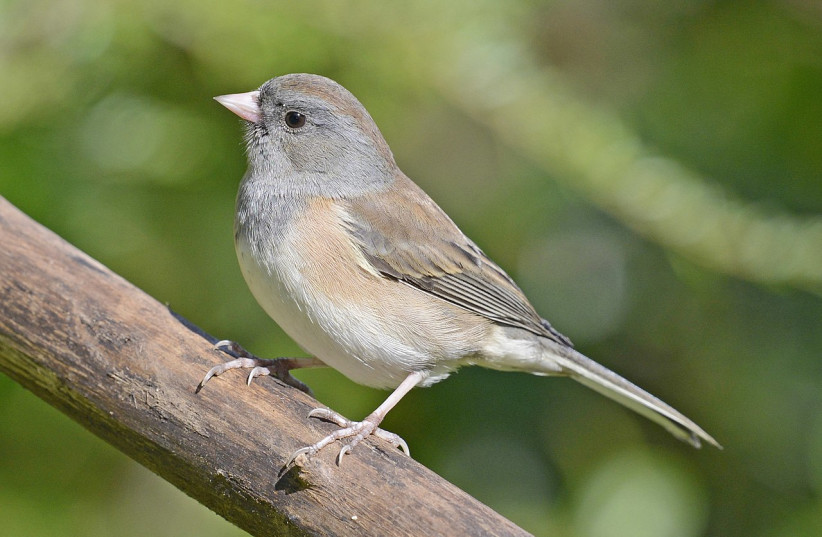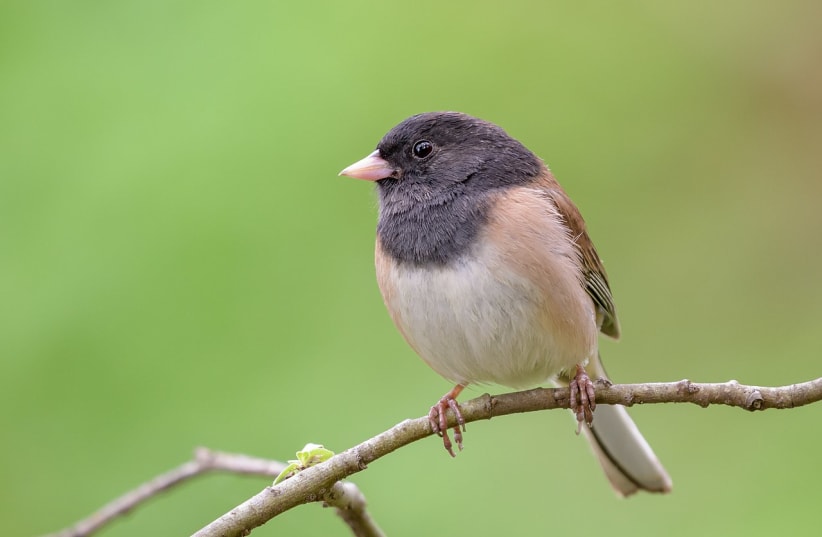Dr. Eleanor Diamant, an ecologist and evolutionary biologist from Ben-Gurion University of the Negev (BGU) in Beersheba, traveled all the way to Los Angeles to study birds called dark-eyed juncos that have thrived at the campus of the University of California for 20 years.
There are no such birds in Israel, as the small grayish bird (Junco hyemalis) live in much of the North and in summer venture far north into the Arctic. It’s often called a “snowbird” because at the end of autumn when you see one, it signals the fact that winter is coming.
Their main source of food is seeds, so they spend most of their time foraging on the ground or from bird feeders. Ornithologists estimate that there are some 630 million juncos in the world. The genus name Junco is the Spanish word for rush, from the Latin word juncus, and its scientific name means “winter junco” from the Latin word hyemalis (“of the winter”).
When UCLA shifted to remote online classes during the early days of COVID-19, the campus was almost empty, but not completely, as several species of animals continued to go about their daily lives – with far fewer disturbances from students and academic staffers. Among them were about 300 juncos.
Likely because of the direct and indirect effects of human activity like vehicular traffic, collisions, light pollution, and noise pollution, some wildlife – specifically urban wildlife – adjusted their behaviors and patterns across the globe.


The group of UCLA scientists led by Diamant who have been studying fear and aggression in urban juncos for years recognized that the dramatic shift in human activity presented a unique opportunity for an experiment: How would juncos adapt once campus life returned to normal?
Would the birds fear humans? It turns out: No
They wondered whether after the year-long respite from any human interaction if the juncos act more fearful once they encountered large groups of people again. Their findings completely defied their expectations.
In a study published in Proceedings of the Royal Society B under the title “Urban birds become less fearful following COVID-19 reopenings,” the scientists report that, once campus life returned to normal, the birds acted “drastically less fearful” of humans. The researchers had speculated before the experiment that once juncos lost their familiarity with people, they would adopt behaviors more like their wilder cousins — who don’t typically let people get closer than about 3.5 meters before flying away – but that was decidedly not the case.
To judge birds’ fear levels, the scientists measured how close a person could get to the birds before they flew away. The researchers conducted the tests throughout the campus closure and again in 2022 after the campus had fully reopened. And they compared their findings with data that UCLA scientists had collected prior to the pandemic, in 2018 and 2019.
Before the closure, juncos allowed researchers to get within about 1.65 meters, on average, before they fled. That figure remained consistent for the duration of the closure. But in 2022, when campus life had mostly returned to normal, juncos allowed people to get even closer – an average of just 99 centimeters – before they flew away. The study also found that during the period of time when people were mostly absent, the birds showed little change in how close they allowed humans to get.
Interestingly, there was no statistically significant difference in the behaviors of birds that hatched during the closure and those who had interacted with people before the pandemic began.
Juncos provided a particularly interesting case study because they feed and nest mostly on the ground, where close encounters with humans are common. Before the pandemic, UCLA’s juncos had become accustomed to the commotion of a large urban university.
There are two main biological theories about how wild birds get used to living around people in densely populated environments. The first holds that birds that encounter large numbers of humans become less fearful over time – a process called habituation. That theory also suggests that birds that live without much human interaction either will become more fearful of people or that their fear response will not change over time. The other theory holds that birds living in cities are there in part because they innately have less fear of humans in the first place.
But Diamant said the study’s findings didn’t line up with either of those theories. “What we found doesn’t match either of them. If less-fearful birds had chosen to live on campus in the first place, we would have expected their fear response to be essentially unchanged. If they were habituated, we would have thought they’d become more fearful during the closure and then less fearful after, or not shift their behavior at all. But these birds didn’t shift fear response with humans absent and they shifted toward much less fearful after humans came back.”
Pamela Yeh, a UCLA professor of ecology and evolutionary biology and the study’s senior author, said that “the effects of humans on wild animals are really complex, and what we expect isn’t always what we get. so our research shows both the complexity of the juncos’ response to humans and of their response to other changes.”
The study also may offer a glimmer of hope for North American birds, whose population has diminished dramatically — due in large part to human disturbances in their natural habitats. By some estimates, there are nearly three billion fewer adult birds in North America alone than there were in 1970, including about 175 million fewer dark-eyed juncos.
